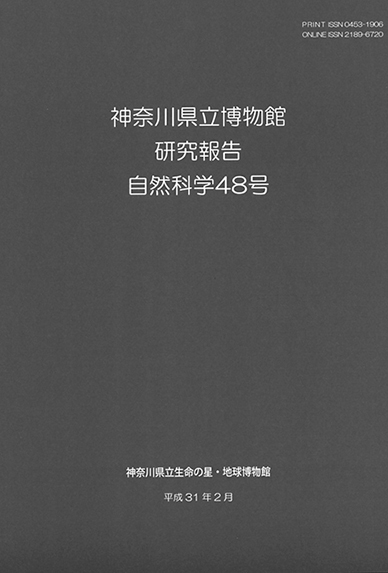Volume 2018, Issue 47
Bulletin of the Kanagawa Prefectural Museum (Natural Science)
Displaying 1-14 of 14 articles from this issue
- |<
- <
- 1
- >
- >|
Cover, Contents
-
2018Volume 2018Issue 47 Pages cover-
Published: 2018
Released on J-STAGE: April 30, 2021
Download PDF (37K) -
2018Volume 2018Issue 47 Pages TOC-
Published: 2018
Released on J-STAGE: April 30, 2021
Download PDF (516K)
Short Article
-
2018Volume 2018Issue 47 Pages 1-6
Published: February 27, 2018
Released on J-STAGE: April 30, 2021
Download PDF (2180K)
Report
-
2018Volume 2018Issue 47 Pages 7-21
Published: February 28, 2018
Released on J-STAGE: April 30, 2021
Download PDF (3848K)
Notes
-
2018Volume 2018Issue 47 Pages 23-33
Published: February 28, 2018
Released on J-STAGE: April 30, 2021
Download PDF (1333K)
Original Article
-
2018Volume 2018Issue 47 Pages 35-57
Published: February 28, 2018
Released on J-STAGE: April 30, 2021
Download PDF (2065K) -
2018Volume 2018Issue 47 Pages 59-
Published: February 28, 2018
Released on J-STAGE: April 30, 2021
Download PDF (2508K) -
2018Volume 2018Issue 47 Pages 67-71
Published: February 28, 2018
Released on J-STAGE: April 30, 2021
Download PDF (754K) -
2018Volume 2018Issue 47 Pages 73-83
Published: February 28, 2018
Released on J-STAGE: April 30, 2021
Download PDF (1420K)
Short Article
-
2018Volume 2018Issue 47 Pages 85-
Published: February 28, 2018
Released on J-STAGE: April 30, 2021
Download PDF (615K) -
2018Volume 2018Issue 47 Pages 89-92
Published: February 28, 2018
Released on J-STAGE: April 30, 2021
Download PDF (736K)
Notes
-
2018Volume 2018Issue 47 Pages 93-105
Published: February 28, 2018
Released on J-STAGE: April 30, 2021
Download PDF (3904K)
imprint, back cover
-
2018Volume 2018Issue 47 Pages 107-
Published: 2018
Released on J-STAGE: April 30, 2021
Download PDF (546K) -
2018Volume 2018Issue 47 Pages 108-
Published: 2018
Released on J-STAGE: April 30, 2021
Download PDF (34K)
- |<
- <
- 1
- >
- >|
